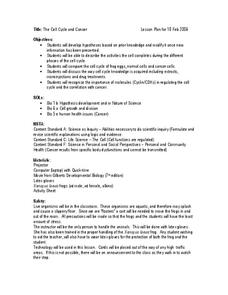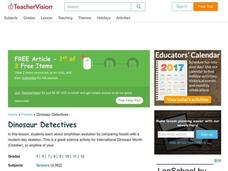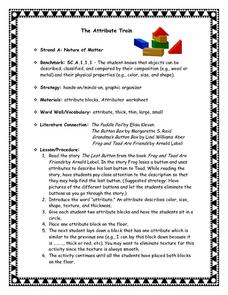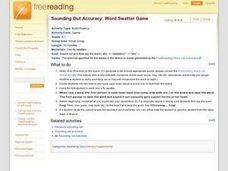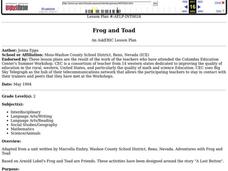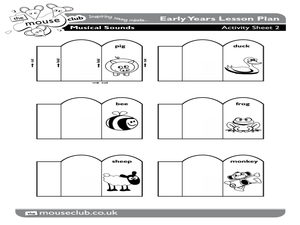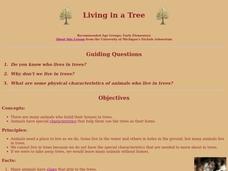Curated OER
Froggy Fun
Students exploring about frogs and their environment. They describe what camouflage is and why it is useful to frogs especially in the environment that frogs live in. They also draw a picture of a frog in its habitat.
Curated OER
Frogz
Learners perform jumps and leaps from one lily pad to another to add to a study of frogs.
Curated OER
The Cell Cycle and Cancer
Students compare and contrast the cell cycle of frog eggs, normal cells, and cancer cells. They watch a video about early development of the frog embryo, generate a hypothesis in small groups, and listen to a teacher-led lecture. ...
Curated OER
Dinosaur Detectives
Students examine amphibian evolution by comparing fossils with a modern-day skeleton. They experience the scientific thought process of drawing conclusions from limited paleontological data. Student groups align the figures with the...
Curated OER
Migration Woes
Students are able to describe the reproductive cycle of the gopher frog. They are able to describe the impacts of habitat loss and degradtion on gopher frog populations. Students are explained that many factors limit the survival of...
Curated OER
Using the senses
Students use their senses to compare a frog and a hamster. In this animals comparison lesson plan, students get into groups and observe, smell, feel, and listen to what their animals are like, and classify them into categories.
Curated OER
The Attribute Train
Students participate in a hands-on activity working with attribute blocks. After reading a story about attributes as a class, they each are given two attribute blocks. The first student lays one attribute block on the floor with the next...
Curated OER
Sounding Out Accuracy: Word Swatter Game
Students explore word fluency by participating in a language arts game. In this vocabulary identification lesson plan, students collaborate in two small teams, each armed with a fly swatter, in order to swat vocabulary words spoken by...
Curated OER
Pond Ecosystem Field Trip
Students investigate the environment by participating in a class trip. In this pond ecosystem lesson, students define a list of vocabulary terms associated with ponds such as invertebrate and metamorphosis. Students attend a field trip...
Curated OER
Tadpoles to Frogs!
Third graders observe the tadpoles/frogs and draw a picture in their journals every week to monitor its growth with 100% accuracy. They observe tadpoles/frogs and record at least two changes or the observations the tadpole undergoes...
Curated OER
Bob and the Frogs Hop on Logs
Learners complete a variety of activities as they explore/review the letter 'o' as it makes the /o/ sound. They recite tongue twisters and practice writing words with the /o/ sound. They read a story and choose /o/ words from the story...
Curated OER
Bump on the Head
Students discuss as a class if they have ever had a bump on the head and started crying and said /a/. They pretend they have hit their head and say the /a/ stretching it out and try a tongue twister containing the sound and write the...
Curated OER
Find the Frog
Students, the advanced beginner to intermediate ESL level, use English in a science activity.
Curated OER
Frog and Toad
Second graders learn vocabulary and use of words, set, attribute Venn diagram. They learn to describe attributes.
Curated OER
Picture This
Students, after explaining the famous quote, "A picture is worth a thousand words," supply the missing words to a wordless story by Mercer Mayer called "A Boy, A Dog, and A Frog." They brainstorm the setting, plot, descriptive words,...
Curated OER
Water, Water Everywhere (Pond Animals)
Second graders examine the characteristics of animals who live in a pond environment. In groups, they describe the various stages in the life of a frog and identify the characteristics of other pond animals. Using this information,...
Curated OER
Let's Make A Dill
Students perform an "autopsy" on a dill pickle to determine its' cause of death. After finding "clues" inside the "body," students organize facts and use their imagination to write an epitaph. As an alternative, students may view a...
Curated OER
Musical Sounds
Students investigate music appreciation by completing worksheets. In this musical arts activity, students complete worksheets in which they identify different musical instruments, the sounds they make and the family of instruments they...
Curated OER
Living in a Tree
Students explore animals that live in trees. In this nature and biology lesson plan, students go outdoors and make observations about animals and their unique body parts that help them to live in trees. Students create drawings as they...
Curated OER
Bodaciously Beautiful Butterflies Take Flight
Students complete study on butterflies using real caterpillars, keep individual daily journals of observations, and complete timeline for their caterpillar/butterfly.
Curated OER
Species Charades
Students identify endangered species. In this endangered species lesson, the teacher leads a discussion about endangered species, then the class plays a game of charades to pantomime animal behavior.
Curated OER
American Frontiers
Students study the settlement of the American frontier through literature. In this literature lesson, students read and discuss works by James Fenimore Cooper, Bret Harte, Mark Twain, Willa Cather, and Hamlin Garland. Students compare...
Curated OER
What Makes a Tropical Rainforest Special?
Students examine the characteristics of the tropical rainforest. Using a map, they locate the rainforests found around the world, continents and the equator. Using the internet, they research the various layers of the rainforest and...
Curated OER
Animal Names
Students match animal pictures with animal words. In this farm animal lesson, students put together the parent and their offspring. Students should have prior knowledge of the basic needs of animals. Students write animal booklets.
Other popular searches
- Math Lesson on Frogs
- Introductory Lesson on Frogs
- Lesson on Frogs Camouflage
- Writing Lesson on Frogs
- Lesson on Frogs Camuflouge


